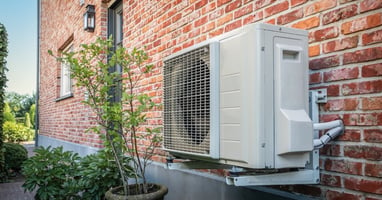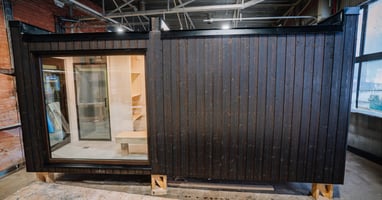We all want our homes to feel nice and cool when the weather warms up. However, installing a...
10 Off Season Maintenance Tips for Your Furnace
.jpg?width=1200&height=628&name=CapitolSuply%26Service-375779-row-mobile-homes-blogbanner1(1).jpg)
Your furnace works hard to keep your home warm and cozy throughout the winter months, but when the colder season ends, it’s easy to forget about this essential appliance. Properly caring for your furnace in the off-season isn’t just a chore; it’s a smart move.
With a little maintenance, you can extend its lifespan, boost energy efficiency, and save money on costly repairs down the road. Let's explore the absolute must-do maintenance tips to tackle during the off-season and keep your furnace in top shape all year round!
Clean or Replace the Air Filter
A clean air filter is essential for your furnace to operate efficiently. Over time, your filter can become clogged with dust, dirt, and other debris, which restricts airflow and forces your furnace to work harder. This not only reduces energy efficiency but can also shorten the lifespan of your unit.
During the off-season, check the air filter and clean or replace it as necessary. You should replace most filters every 1-3 months, depending on the manufacturer's recommendations or your home’s dust levels. A clean air filter means better airflow and fresher, healthier air for your home, helping you breathe easily!
.jpg?width=1200&height=628&name=CapitolSupply%26Service-375779-woman-checking-thermostat-image-a1%20(1).jpg)
Check the Thermostat
Your thermostat is the brain of your heating system, so keeping it in top shape is a must. During the off-season, give it a quick test by adjusting the temperature to make sure it’s syncing with your furnace properly.
Are you still using a manual thermostat? It might be time for an upgrade. Programmable and smart thermostats not only save you money on energy bills but also give you smarter, easier control over your home’s comfort. Why settle for outdated technology when you could save energy and stay cozy with the push of a button?
Clean Air Vents and Ducts
Dust and debris can accumulate in your air vents and ductwork even when your furnace isn’t in use. Blocked or dirty vents reduce airflow and negatively impact indoor air quality. Take time to vacuum vent covers and inspect for obstructions.
Contact a professional if you haven’t had your ducts properly cleaned in several years—it’s a worthwhile investment. Cleaning vents and ducts improves air quality, prevents allergens from circulating, and keeps your HVAC system running efficiently.
Examine the Furnace Belt (if applicable)
Many furnaces, especially older models or those with belt-driven blowers, rely on a furnace belt to operate correctly. Over time, the belt can develop cracks, loosen, or wear down, potentially leaving you with a furnace that won’t start when the cold weather arrives.
During the off-season, inspect the belt for signs of damage. If you notice any cracks, significant wear, or if the belt feels loose, it’s time to replace it. Check your manufacturer’s manual for guidance, or reach out to a technician if you need assistance.
Check the Pilot Light or Electric Ignition
For gas furnaces, the pilot light is a crucial feature that must remain lit for the system to function correctly. Check the pilot light to ensure it’s burning a steady blue flame. A yellow or flickering flame could indicate an issue, such as dirt on the burners or improper gas flow, which requires professional attention. For furnaces with an electric ignition, examine the component for any obvious signs of damage, corrosion, or loose connections.
Test for Gas Leaks or Strange Smells
A gas leak or unusual smell around your furnace should never be ignored. Gas leaks pose serious safety risks, including fire hazards and carbon monoxide poisoning. If you smell a rotten egg or sulfur odor around your furnace, there may be a possible leak in your system.
You can also apply a mixture of soapy water in a thin layer to the gas lines and connections. If you notice bubbles forming anywhere, then it’s an indication of a leak. If you suspect a gas leak, shut off the gas supply immediately and contact a professional to come out for an inspection. Additionally, install carbon monoxide detectors in your home as an extra layer of protection, as carbon monoxide is a colorless, odorless, and potentially deadly gas.
Inspect the Heat Exchanger
The heat exchanger is a critical component of your furnace that transfers heat from burning fuel to your home while keeping harmful combustion gases contained. Over time, the heat exchanger can develop cracks due to wear and tear, potentially allowing dangerous gases like carbon monoxide to leak into your home.
Thoroughly inspect the heat exchanger for visible cracks or signs of deterioration. If you’re unsure what to look for, consult a professional technician to perform a detailed assessment. Regular inspections ensure the heat exchanger remains intact, allowing your system to operate safely and efficiently.
Seal Up Any Gaps Around the Furnace
Gaps around your furnace can result in inefficiencies by allowing heated air to escape or cold drafts to enter nearby spaces. These leaks can lead to increased energy usage and discomfort in your home.
Check for gaps or cracks in the areas around the furnace housing or ductwork. Use heat-resistant caulking or weatherstripping to seal these spaces and improve the furnace's overall efficiency. Ensuring proper insulation also keeps your system running smoothly and saves on energy costs over time.
Turn Off the Furnace if Not in Use
If you live in a region with distinct seasonal weather patterns, consider turning off your furnace during the warmer months when it’s not needed. This not only extends the lifespan of your furnace but also reduces unnecessary energy consumption.
Start by switching your thermostat to the “off” position, then consider shutting off the power supply at the electrical panel. However, don’t forget to turn it back on before colder weather arrives. This gives you time to address any issues before the season begins.
.jpg?width=1200&height=628&name=CapitolSupply%26Service-375779-working-compnents-furnace-image-b1(1).jpg)
Schedule a Professional Inspection
Even with regular maintenance, it's essential to schedule an annual professional inspection for your furnace. Certified technicians have the tools and expertise to identify underlying problems that may not be apparent during routine checks.
They can clean internal components, test for leaks, and ensure that everything is functioning efficiently. A professional inspection can help detect issues early, reducing the likelihood of costly repairs or emergency breakdowns during peak heating months.
Regular furnace tune-ups do more than just keep your home cozy; they keep your system running safely, boost its lifespan, and ensure your comfort all season long. If you’ve followed our off-season maintenance tips and happen to notice your furnace needs some TLC, don’t wait for a small problem to become an insurmountable one.
At Capitol Supply & Service, we’re the experts in mobile home furnaces. Whether you need a new furnace installed or an old one repaired, we’ve got you covered. We offer a wide selection of affordable furnaces, perfect for small and large mobile homes. Your heating system is too important to leave to chance. Trust our team to provide reliable, professional service that keeps your home comfortable when it matters most.



